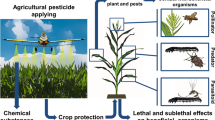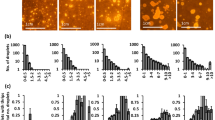Abstract
The establishment of predatory mites on protected crops is affected by the availability of shelter and alternative food. We suggest that a pollen covered twine, coined here “pollen on-twine”, may provide these necessities when attached to the plant. We evaluated the effect of twine types and two pollen species on the establishment of Euseius scutalis (Athias-Henriot) and Amblyseius swirskii Athias-Henriot on pre-flowering pepper plants in a growth chamber. For both phytoseiids, rayon jute twine was found more beneficial while corn and oak pollen did not differ in their effect. Though populations of both predators were best promoted when twine and pollen were applied separately, E. scutalis population increased by more than tenfold and A. swirskii doubled when plants were applied with pollen on-twine. We propose that after further refining, pollen on-twine can serve as a feasible solution for predatory mite establishment on protected crops.



Similar content being viewed by others
References
Adar E, Inbar M, Gal S, Doron N, Zhang ZQ, Palevsky E (2012) Plant-feeding and non-plant feeding phytoseiids: differences in behavior and cheliceral morphology. Exp Appl Acarol 58:341–357
Argov Y, Amitai S, Beattie GAC, Gerson U (2002) Rearing, release and establishment of imported predatory mites to control citrus rust mite in Israel. BioControl 47:399–409
Argov Y, Berkeley M, Domeratzky S, Melamed E, Weintraub P, Palevsky E (2006) Identification of pollens for small scale mass rearing of Neoseiulus californicus and a novel method for quality control. IOBC/WPRS Bull 29(4):127–132
Biobest News & press releases (2013) Biobest introduces Dyna-Mite®: a new predatory mite strategy in rose. Biobest Belgium N.V. http://www.biobest.be/nieuws/289/3/0/. Accessed 14 Jan 2014
Bolckmans K, van Houten Y, Hoogerbrugge H (2005) Biological control of whiteflies and western flower thrips in greenhouse sweet peppers with the phytoseiid predatory mite Amblyseius swirskii Athias-Henriot (Acari: Phytoseiidae). In: Hoddle M (ed) Second International Symposium on biological control of arthropods. U.S. Department of Agriculture, Forest Service, Switzerland, pp 555–565
Boulard T, Fatnassi H, Roy JC, Lagier J, Fargues J, Smits N, Rougier M, Jeannequin B (2004) Effect of greenhouse ventilation on humidity of inside air and in leaf boundary-layer. Agricult Forest Meteorol 125:225–239
Castagnoli M, Simoni S (1999) Effect of long-term feeding history on functional and numerical response of Neoseiulus californicus (Acari: Phytoseiidae). Exp Appl Acarol 23:217–234
Conover WJ, Iman RL (1981) Rank transformations as a bridge between parametric and nonparametric statistics. Am Statist 35:124–129
Duso C (1992) Role of Amblyseius aberrans (Oud.), Typhlodromus pyri Scheuten and Amblyseius andersoni (Chant) (Acari, Phytoseiidae) in vineyards. J Appl Entomol 114:455–462
Elbadry EA, Elbenhawy EM (1968) The effect of non-prey food, mainly pollen, on the development, survival, and fecundity of Amblyseius gossipi (Acarina: Phytoseiidae). Entomol Exp Appl 11:269–272
Faraji F, Janssen A, Sabelis MW (2002) Oviposition patterns in a predatory mite reduce the risk of egg predation caused by prey. Ecol Entomol 27:660–664
Ferreira JAM, Eshuis B, Janssen A, Sabelis M (2008) Domatia reduce larval cannibalism in predatory mites. Ecol Entomol 33:374–379
Ferreira JAM, Cunha DFS, Pallini A, Sabelis MW, Janssen A (2011) Leaf domatia reduce intraguild predation among predatory mites. Ecol Entomol 36:435–441
Frank S (2010) Biological control of arthropod pests using banker plant systems: past progress and future directions. Biol Control 52:8–16
Gan-Mor S, Bechar A, Ronen B, Eisikowitch D, Vaknin Y (2003) Electrostatic pollen applicator development and tests for almond, kiwi, date and pistachio—an overview. Appl Eng Agric 19:119–124
Gan-Mor S, Palevsky E, Ronen B (2011) A device and a method for pollen application for enhancing biological control. United States PCT 12/984,462, Jan-04-2011
Goleva I, Zebitz CPW (2013) Suitability of different pollen as alternative food for the predatory mite Amblyseius swirskii (Acari, Phytoseiidae). Exp Appl Acarol 61:259–283
Grostal P, Odowd DJ (1994) Plants, mites and mutualism—leaf domatia and the abundance and reproduction of mites on Viburnum tinus (Caprifoliaceae). Oecologia 97:308–315
Huang N, Enkegaard A, Osborne LS, Ramakers PJ, Messelink GJ, Pijnakker J, Murphy G (2011) The banker plant method in biological control. Crit Rev Plant Sci 30:259–278
Jacobson RJ, Croft P, Fenlon J (2010) Suppressing establishment of Frankliniella occidentalis Pergande (Thysanoptera: Thripidae) in cucumber crops by prophylactic release of Amblyseius cucumeris Oudemans (Acarina: Phytoseiidae). Biocontrol Sci Technol 11:27–34
Kreiter S, Tixier MS, Croft BA, Auger P, Barret D (2002) Plants and leaf characteristics influencing the predaceous mite Kampimodromus aberrans (Acari: Phytoseiidae) in habitats surrounding vineyards. Environ Entomol 31:648–660
Loughner R, Goldman K, Loeb G, Nyrop J (2008) Influence of leaf trichomes on predatory mite (Typhlodromus pyri) abundance in grape varieties. Exp Appl Acarol 45:111–122
Loughner R, Wentworth K, Loeb G, Nyrop J (2010) Influence of leaf trichomes on predatory mite density and distribution in plant assemblages and implications for biological control. Biol Control 54:255–262
Loughner R, Nyrop J, Wentworth K, Sanderson J (2011) Effects of supplemental pollen and fibers on canopy abundance of Amblyseius swirskii. IOBC/WPRS Bull 68:105–109
Maoz Y, Gal S, Argov Y, Coll M, Palevsky E (2011) Biocontrol of persea mite, Oligonychus perseae, with an exotic spider mite predator and an indigenous pollen feeder. Biol Control 59:147–157
McMurtry JA, Croft BA (1997) Life-styles of phytoseiid mites and their roles in biological control. Annu Rev Entomol 42:291–321
McMurtry JA, Scriven GT (1966) Studies on predator-prey interactions between Amblyseius hibisci and Oligonychus punicae (Acarina: Phytoseiidae, Tetranychidae) under greenhouse conditions. Ann Entomol Soc Am 59:793–800
McMurtry JA, de Moraes GJ, Sourassou NF (2013) Revision of the lifestyles of phytoseiid mites (Acari: Phytoseiidae) and implications for biological control strategies. Syst Appl Acarol 18:297–320
Nomikou M, Janssen A, Schraag R, Sabelis MW (2001) Phytoseiid predators as potential biological control agents for Bemisia tabaci. Exp Appl Acarol 25:271–291
Nomikou M, Janssen A, Schraag R, Sabelis MW (2002) Phytoseiid predators suppress populations of Bemisia tabaci on cucumber plants with alternative food. Exp Appl Acarol 27:57–68
Nomikou M, Sabelis MW, Janssen A (2010) Pollen subsidies promote whitefly control through the numerical response of predatory mites. BioControl 55:253–260
Norton AP, English Loeb G, Belden E (2001) Host plant manipulation of natural enemies: leaf domatia protect beneficial mites from insect predators. Oecologia 126:535–542
Onzo A, Houedokoho AF, Hanna R (2011) Potential of the predatory mite, Amblyseius swirskii to suppress the broad mite, Polyphagotarsonemus latus on the gboma eggplant, Solanum macrocarpon. J Insect Sci 12:1–11
Palevsky E, Argov Y, Ben David T, Gerson U (2003) Identification and evaluation of potential predators of citrus rust mite. Syst Appl Acarol 8:39–48
Ragusa S, Swirski E (1975) Feeding habits, development and oviposition of the predacious mite Amblyseius swirskii Athias-Henriot (Acarina: Phytoseiidae) on pollen of various weeds. Israel J Entomol 10:93–103
Ramakers PMJ, Voet SJP (1995) Use of castor bean, Ricinus communis, for the introduction of the thrips predator Amblyseius degenerans on glasshouse-grown sweet peppers. Meded Fac Landbouwk en Toeg Biol Wet Univ Gent 60:885–891
Ramakers PJ, Voet SJP (1996) Introduction of Amblyseius degenerans for thrips control in sweet peppers with potted castor beans as banker plants. IOBC/WPRS Bull 19(1):127–130
Roda A, Nyrop J, Dicke M, English Loeb G (2000) Trichomes and spider-mite webbing protect predatory mite eggs from intraguild predation. Oecologia 125:428–435
Roda A, Nyrop J, English Loeb G, Dicke M (2001) Leaf pubescence and two-spotted spider mite webbing influence phytoseiid behavior and population density. Oecologia 129:551–560
Roda A, Nyrop J, English-Loeb G (2003) Leaf pubescence mediates the abundance of non-prey food and the density of the predatory mite Typhlodromus pyri. Exp Appl Acarol 29:193–211
Romero GQ, Benson WW (2005) Biotic interactions of mites, plants and leaf domatia. Cur Opin Plant Biol 8:436–440
Seelmann L, Auer A, Hoffmann D, Schausberger P (2007) Leaf pubescence mediates intraguild predation between predatory mites. Oikos 116:807–817
Swirski E, Amitai S, Dorzia N (1967) Laboratory studies on the feeding, development and reproduction of the predaceous mites Amblyseius rubini Swirski and Amitai and Amblyseius swirskii Athias (Acarina: Phytoseiidae) on various kinds of food substances. Israel J Agric Res 17:101–119
Tixier MS, Kreiter S, Okassa M, Cheval B (2010) A new species of the genus Euseius Wainstein (Acari: Phytoseiidae) from France. J Nat Hist 44:241–254
Tuovinen T, Lindqvist I (2010) Maintenance of predatory phytoseiid mites for preventive control of strawberry tarsonemid mite Phytonemus pallidus in strawberry plant propagation. Biol Control 54:119–125
van Maanen R, Vila E, Sabelis MW, Janssen A (2010) Biological control of broad mites (Polyphagotarsonemus latus) with the generalist predator Amblyseius swirskii. Exp Appl Acarol 52:29–34
van Rijn PCJ, Sabelis MW (1990) Pollen availability and its effect on the maintenance of populations of Amblyseius cucumeris, a predator of thrips. IOBC/WPRS Bull 13(5):179–184
van Rijn PCJ, van Houten YM, Sabelis MW (1999) Pollen improves thrips control with predatory mites. IOBC/WPRS Bull 22(1):209–212
van Rijn PCJ, van Houten YM, Sabelis MW (2002) How plants benefit from providing food to predators even when it is also edible to herbivores. Ecology 83:2664–2679
Wäckers FL (2005) Suitability of (extra-) floral nectar, pollen and honeydew as insect food sources. In: Wäckers FL, van Rijn PCJ, Bruijn J (eds) Plant-provided food for carnivorous insects: a protective mutualism and its applications. Cambridge University Press, Cambridge, UK, pp 17–74
Wäckers FL, Romeis J, van Rijn PCJ (2007) Nectar and pollen feeding by insect herbivores and implications for multitrophic interactions. Annu Rev Entomol 52:301–323
Walter DE (1996) Living on leaves: mites, tomenta, and leaf domatia. Annu Rev Entomol 41:101–114
Weintraub PG, Kleitman S, Mori R, Gan-Mor S, Gannot L, Palevsky E (2009) Novel application of pollen to augment the predator Amblyseius swirskii on greenhouse sweet pepper. IOBC/WPRS Bull 50:119–124
Acknowledgments
We would like to thank Bio-Bee, Israel, and especially Shimon Steinberg, Yehoshua Kaminsky and Arnon Alouche for their cooperation, collaboration and for supplying some of the materials and mites needed for this study. We are grateful to Yonatan Maoz for his technical support and Matan Ben-Ari, Alon Lotan and Prof. Ido Izhaki for their statistical guidance.
Author information
Authors and Affiliations
Corresponding author
Additional information
Handling Editor: Patrick De Clercq.
Rights and permissions
About this article
Cite this article
Adar, E., Inbar, M., Gal, S. et al. Pollen on-twine for food provisioning and oviposition of predatory mites in protected crops. BioControl 59, 307–317 (2014). https://doi.org/10.1007/s10526-014-9563-1
Received:
Accepted:
Published:
Issue Date:
DOI: https://doi.org/10.1007/s10526-014-9563-1




